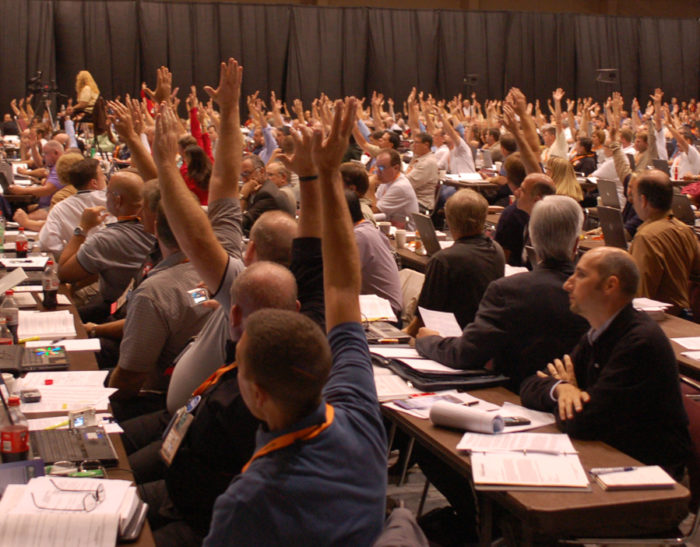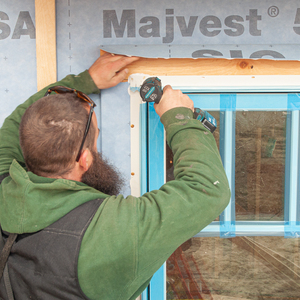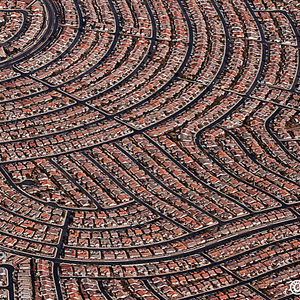
Image Credit: International Code Council
Proposed Code Changes Were Weakened After NAHB Lobbying
FAIRFAX, VA — Because of changes to the International Energy Conservation Code (IECC) approved at last September’s ICC hearings in Minneapolis, houses built to the prescriptive requirements of the 2009 IECC will use 12.2% less energy on average than houses built to the 2006 IECC. The energy savings percentage was included in a recent report by a Fairfax, Virginia consulting firm, ICF International.
At the 2008 Minneapolis hearings, a more sweeping code change proposal — the so-called Thirty Percent Solution — was defeated after vigorous opposition from representatives from the National Association of Home Builders (NAHB), Icynene Incorporated, and Pilkington Glass. The Thirty Percent Solution was supported by a wide coalition of organizations, including the U.S. Department of Energy, the U.S. Conference of Mayors, the National Association of State Energy Officials and the Energy Efficient Codes Coalition.
Supporters of a more stringent energy code have been waiting patiently for the calculation of the energy-savings percentage attributable to the limited IECC code changes adopted after the Thirty Percent Solution was defeated. Most back-of-the-envelope calculations were higher than the 12.2% figure announced by ICF International, so many supporters of the Thirty Percent Solution were disappointed by the news.
“We need more insulation on and in walls in just about all climate zones,” said Chris Mathis, an energy expert and president of Mathis Consulting. “I’m very happy we got some savings, but I think we ought to feel a little bit of ‘shame on us.’ What you see are the missed opportunities. We got part of the basket of goods, but we didn’t end up making any of the hard decisions we needed to make. I think that we have missed a huge opportunity to make a dramatic statement about the changes needed in the way we build.”
The approved prescriptive code changes responsible for the 12.2% reduction in energy use include the following:
-
The maximum U-factor for vertical windows was reduced from 0.75 to 0.65 in climate zone 2, from 0.65 to 0.50 in climate zone 3, and from 0.40 to 0.35 in climate zone 4.
- The maximum solar heat gain coefficient for vertical windows was reduced from 0.40 to 0.30 in climate zones 1, 2, and 3.
- The minimum wall insulation requirement in climate zones 5 and 6 was increased to R-20.
- The minimum basement wall insulation requirement was increased to R-15/R-19 in climate zones 6-8, and increased to R-5/R-13 in climate zone 3.
- The minimum floor insulation requirement increased in climate zones 7-8 to R-38.
- A new code provision requires either a visual inspection of certain building envelope components or a blower-door test result showing a maximum of 7 air changes per hour @ 50 pascals.
- A new code provision requires duct leakage testing when air handler and ducts are not located entirely within the conditioned envelope.
- A new code provision requires that at least 50% of installed lighting fixtures must be at least as efficient as compact fluorescent lights.
Of course, the energy savings will apply only in areas where the 2009 IECC is both adopted — the easy part — and enforced. In most areas of the U.S. today, many requirements of existing energy codes are rarely enforced. To read the full ICF International report, visit thirtypercentsolution.org.
Weekly Newsletter
Get building science and energy efficiency advice, plus special offers, in your inbox.















2 Comments
Enforcement
Your last paragraph is the key to the entire issue. No matter how good a code is, if it is not enforced, it is useless. Several years ago I was on my state's energy policy council, filled mostly with industry hacks with no interest in actually accomplishing anything, and I made a suggestion that we should include a recommendation that we invest in training and enforcement of the energy code. This suggestion was ridiculed until I pointed out that it was the equivalent of putting more cops on the street - we have the laws, we just need to enforce them. We got the point in the plan, but unfortunately, very little of the plan was actually implemented. If, somehow, we could enforce the enforcement of the energy code, we would all benefit. I'm not holding my breath.
If we could just enforce the manual J requirement...
Our local planning board met with representatives from the building community to ask what we thought about the county mandating all new homes meet Energy Star and LEED-h with in two years. Imagine the reception from NAHB to that!
But we pointed out that while the county requires builders to submit proof of termite treatment for a CO they were still not even enforcing the Manual J requirement which results in in-efficient, over-sized air conditioners and attendant humidity and mold problems. Even though reps of the local HBA pointed out the benefit of requiring manual J the county is still not requiring proof that a manual J has been done to award a certificate of occupancy.
I agree that it is appalling, though not unexpected, that the NAHB continues to fight energy efficiency and even worse that representatives from the glass and open cell foam industries should be part of this. We need to build a stronger green building culture with in the NAHB.
At the 2005 NAHB international Building Show in Orlando I spoke with Ed Nickles, NAHB board member and author of the Trade Contractor Handbook, about NAHB's refusal to allow the shuttle to the Not-So-Big show house to take on passengers at the convention center despite the fact that Sarah Susanka's talks were crowded with standing room only and lines out into the hall. His response "Maybe the Not-So-Big House is just Not-Such-a-Big Deal!"
This year Ed is a certified Green Practitioner and just completed an NAHB gold rated green show home that earned a HERS 48 and is under 2,000 sf. Despite the dark clouds in the sky, change is in the air.
Log in or create an account to post a comment.
Sign up Log in